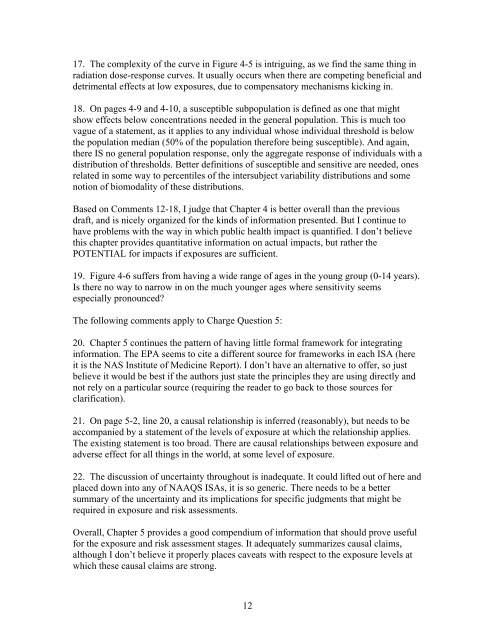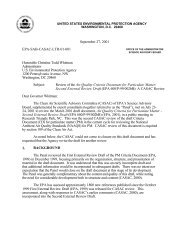(CASAC) Peer Review of EPA's Integrated Science Assessment
(CASAC) Peer Review of EPA's Integrated Science Assessment
(CASAC) Peer Review of EPA's Integrated Science Assessment
Create successful ePaper yourself
Turn your PDF publications into a flip-book with our unique Google optimized e-Paper software.
17. The complexity <strong>of</strong> the curve in Figure 4-5 is intriguing, as we find the same thing inradiation dose-response curves. It usually occurs when there are competing beneficial anddetrimental effects at low exposures, due to compensatory mechanisms kicking in.18. On pages 4-9 and 4-10, a susceptible subpopulation is defined as one that mightshow effects below concentrations needed in the general population. This is much toovague <strong>of</strong> a statement, as it applies to any individual whose individual threshold is belowthe population median (50% <strong>of</strong> the population therefore being susceptible). And again,there IS no general population response, only the aggregate response <strong>of</strong> individuals with adistribution <strong>of</strong> thresholds. Better definitions <strong>of</strong> susceptible and sensitive are needed, onesrelated in some way to percentiles <strong>of</strong> the intersubject variability distributions and somenotion <strong>of</strong> biomodality <strong>of</strong> these distributions.Based on Comments 12-18, I judge that Chapter 4 is better overall than the previousdraft, and is nicely organized for the kinds <strong>of</strong> information presented. But I continue tohave problems with the way in which public health impact is quantified. I don’t believethis chapter provides quantitative information on actual impacts, but rather thePOTENTIAL for impacts if exposures are sufficient.19. Figure 4-6 suffers from having a wide range <strong>of</strong> ages in the young group (0-14 years).Is there no way to narrow in on the much younger ages where sensitivity seemsespecially pronounced?The following comments apply to Charge Question 5:20. Chapter 5 continues the pattern <strong>of</strong> having little formal framework for integratinginformation. The EPA seems to cite a different source for frameworks in each ISA (hereit is the NAS Institute <strong>of</strong> Medicine Report). I don’t have an alternative to <strong>of</strong>fer, so justbelieve it would be best if the authors just state the principles they are using directly andnot rely on a particular source (requiring the reader to go back to those sources forclarification).21. On page 5-2, line 20, a causal relationship is inferred (reasonably), but needs to beaccompanied by a statement <strong>of</strong> the levels <strong>of</strong> exposure at which the relationship applies.The existing statement is too broad. There are causal relationships between exposure andadverse effect for all things in the world, at some level <strong>of</strong> exposure.22. The discussion <strong>of</strong> uncertainty throughout is inadequate. It could lifted out <strong>of</strong> here andplaced down into any <strong>of</strong> NAAQS ISAs, it is so generic. There needs to be a bettersummary <strong>of</strong> the uncertainty and its implications for specific judgments that might berequired in exposure and risk assessments.Overall, Chapter 5 provides a good compendium <strong>of</strong> information that should prove usefulfor the exposure and risk assessment stages. It adequately summarizes causal claims,although I don’t believe it properly places caveats with respect to the exposure levels atwhich these causal claims are strong.12
















